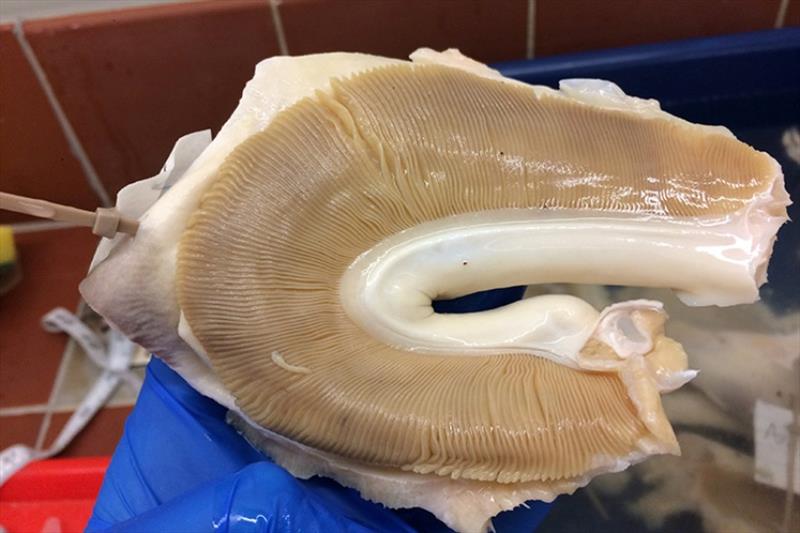
Study reveals link between shark physical traits and ecology
by NOAA Fisheries 30 Jul 2024 00:02 UTC

The gill lamellae of a Blacktip shark (Carcharhinus limbatus) on one gill arch © NOAA Fisheries / Jennifer Bigman
A new study on sharks finds that physical traits related to oxygen uptake can be measured from accurate drawings of nearly all sharks.
Scientists learned more about the critical relationship between a species' ecology (habitat, activity, size) and oxygen uptake. This is traditionally measured by transporting an animal to a laboratory and measuring oxygen consumption in a controlled setting. This is difficult to do for large-bodied, free-swimming organisms such as sharks.
A preceding study uncovered a relationship between gill surface area and gill slit height, two physical traits that are related to oxygen uptake. This means the larger the gill slit height, the larger the internal surface area, and the larger capacity for oxygen uptake. However, gill surface area takes about 20-40 hours to measure per individual and requires sacrificing the animal. The researchers showed that they can get an idea of the oxygen uptake just by measuring gill slit height on physical specimens or from anatomically-correct drawings. As a result, they are able to use these drawings for future work to avoid lethal sampling.
Drawing out insights
Scientists used a field guide called Sharks of the World, which showed drawings of sharks with accurate depictions of the gills. Sharks are often referred to as data-poor from the lack of information available. From this guide, scientists were able to get accurate information on gill slit height for 455 species of sharks and relate it to a species' ecology.
"Our work shows gill slit height taken from drawings provides a lot of information about the lifestyle of the shark, such as its activity, maximum size, and how deep it can live," said Fish Biologist Jennifer Bigman, Ph.D., formerly with the Alaska Fisheries Science Center and now with NOAA's Office of Science and Technology. Bigman also serves on the Ph.D. committee of the lead author of the study. "Gill slit height helps us understand the patterns of oxygen demands across species. This enables us to get survival, growth, and reproduction information for data-poor species like sharks."
Non-invasive research saves time and resources
Examining some traits like gill surface area requires costly and lethal sampling. Measurements from anatomically-accurate drawings in field guides offer the opportunity to understand relationships between physical traits and ecology without the need for any sampling.
This method also saves time—taking samples is a laborious process. It takes a scientist 25 hours to examine the gill slit surface area for a single individual. Gill slit height measurements are usually equivalent whether measured on live specimens or in illustrations. However, measuring from illustrations can be made in a matter of minutes.
Important findings for climate change and shark survival
Understanding oxygen demand is an important first step in predicting the effects of climate change on sharks. Oxygen demand and energy expenditure is related to habitat choice, and as conditions change, this research will provide insight on how climate change is affecting the distribution for these data-poor species.
"The next steps would be to understand how gill slit height relates to life history and survival," said Bigman. "We plan to extend this research to find relationships between physical traits and other life history traits such as growth, maturation size, rather than just maximum size. We aim to continue this research to find patterns across species."